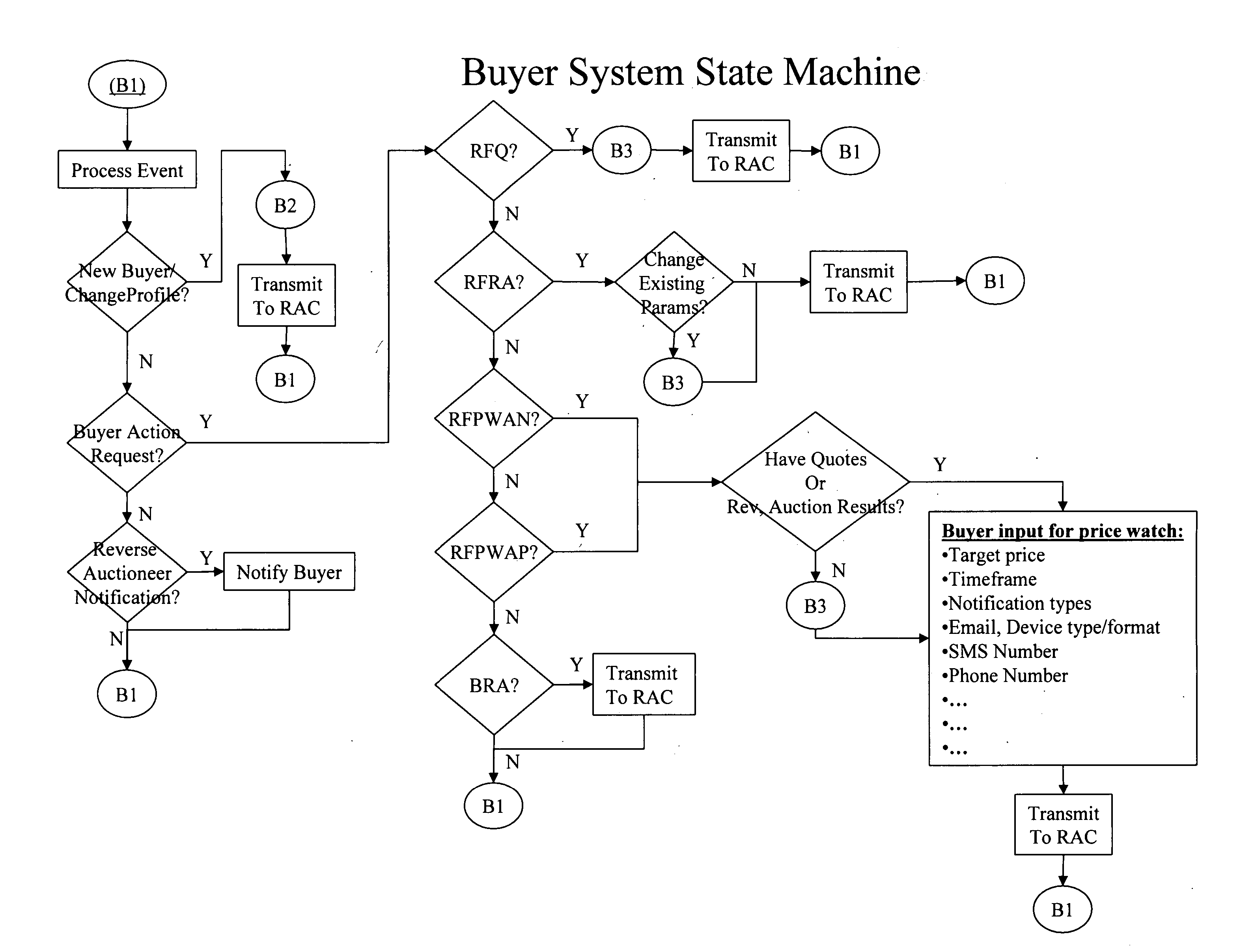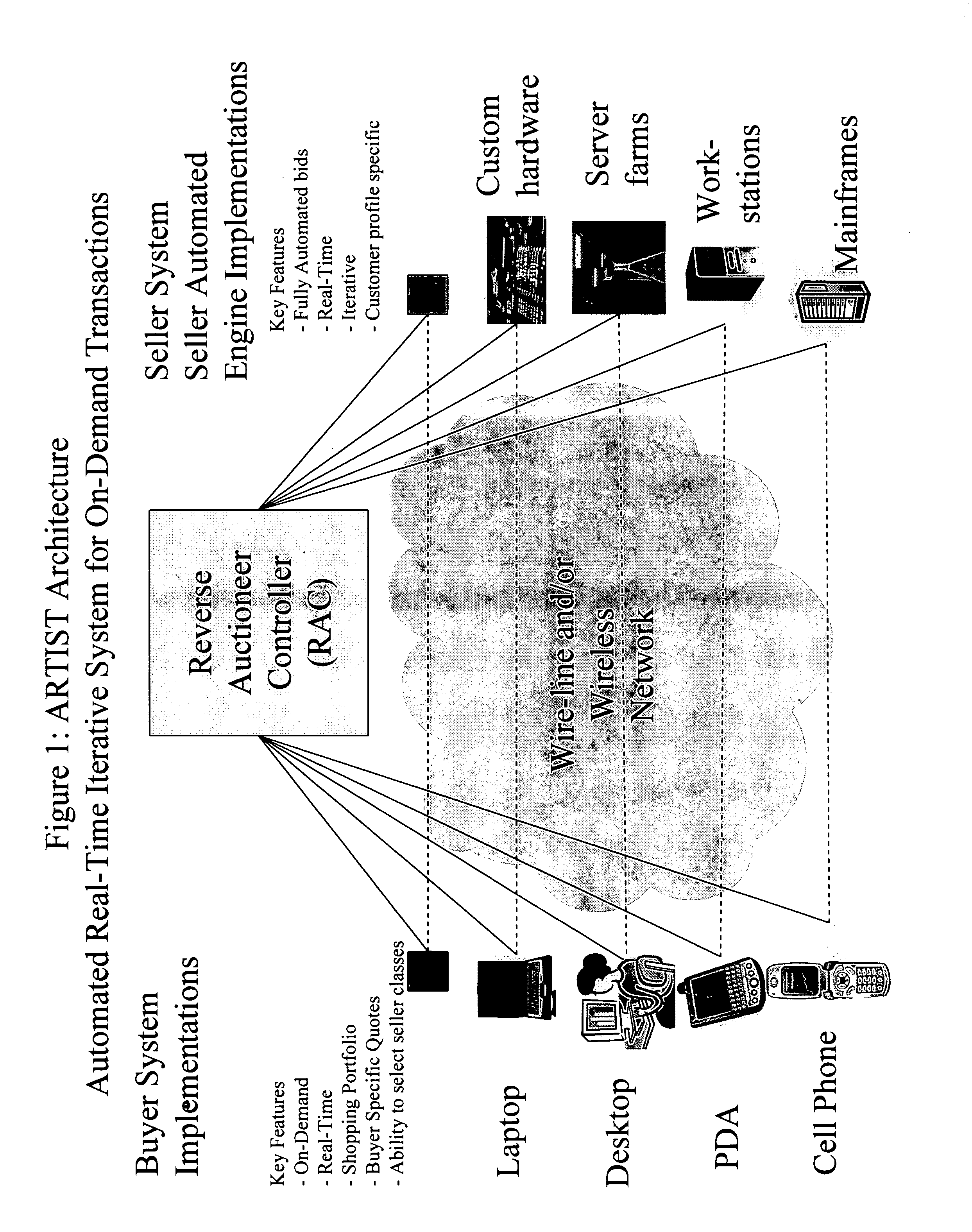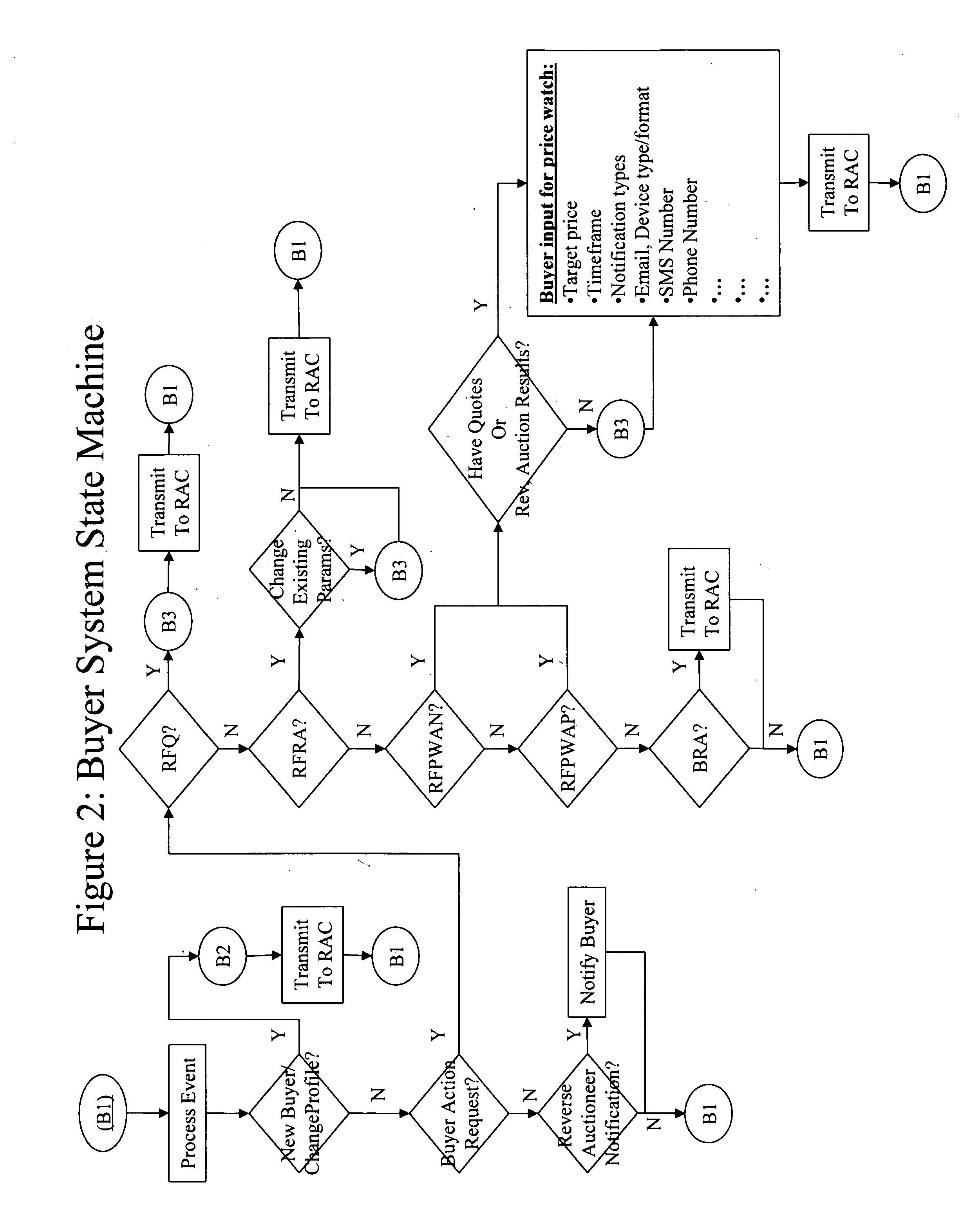In co-pending US
patent application Serial No. 298,967, publication No. 2004 / 0098477 of Reiner Kraft of IBM, published May 20, 2004, it is stated that, despite the development of Internet web search engines and web crawlers for trying to match buyers requests with sellers offers, the prior art had not yet provided a method of communication between buyer and sellers that allows a free marketplace interaction—a need that “has heretofore remained unsatisfied”.
In an environment of a large number of suppliers of similar goods, indeed, buyers and sellers face different problems.
The current mechanisms, both on-line and off-line, are inefficient and their response is either non-instantaneous or provides a quality of information that is stale.
From the seller's perspective, furthermore, the existing solutions do not allow sellers to be highly responsive either to the competition or to the customers.
They are forced to spend dedicated man-power and associated expenditures for current on-line non-automated, largely non-real-time systems which, indeed, may even neutralize any meaningful derivable benefits.
These approaches and their variations, however, suffer from a number of serious constraints due to their inherent limitations.
The challenges are, however, that the search is non-exhaustive, highly influenced by the advertisers, the information received is often stale and not consistent across various sellers resulting in apple-to-orange comparisons; and, with respect to this example,
medicine suppliers are not forced iteratively to bid amongst themselves to offer the best possible competitive price.
Different sellers, indeed, update the pricing data at different frequencies independent of one another and subject to their own
resource constraints.
Thus, in between these updates, the data provided by the reverse auctioneer to the buyer's ‘request for lowest pricing’ is usually stale, non-competitive and inaccurate.
At times, some reverse auctioneers use a one time email process where sellers provide an updated price in response to the email request—a non-instantaneous and non-competitive process.
The buyer waits until these emails have been manually answered—a process that can take hours or days.
This lack of on-demand accurate response, coupled with the lack of competition, actually demonstrates that this kind of manual ‘Reverse Auction’ is, indeed, a misnomer, though the term is used primarily for marketing promotion purposes.
Unfortunately, the solution proposed therein to use peer-to-peer seller network technology also has inherent serious limitations.
The burden is on the buyer to verify each such selling peer's legitimacy, reputation and history—a very challenging and
time consuming effort indeed.
This proposed solution, moreover, imposes a far higher burden on the buyer both in terms of functions to be performed and the responsibilities, and makes it very
time consuming.
The inherent
long latency and other well-known limitations of the peer-to-peer networks combined with the requisite active manual intervention of the buyer may even result in not only a potentially slower
system, but also a far more buyer-adverse
system than the previously discussed proposals.
As mentioned above, such ‘conventional’ prior art proposed solutions, suffer from a significant number of limitations that tend to prevent the buyer from realizing the opportunity to get the best real-time price or value on-demand, and the opportunity for the sellers to realize the opportunity to offer the most competitive prices, as will now be summarized.
First, in the response to the buyer's request, the prices provided by the reverse auctioneer immediately after the request are typically stale; some by hours, some by days, weeks or a month.
The information provided from the data base on behalf of a large number of sellers, even for a
single product, is accordingly typically stale.
The e-mail request process is very slow as it relies on collecting information in non-real time, with the buyer being made to wait until all the sellers have responded at their own pace within their respective constrained resources, which can well take hours or days.
As for the Kraft-IBM peer-to-peer network
system, the ‘Request for Quote’ itself could take hours through the network, thus neutralizing the attempt for approaching real-time competitive pricing.
At times, it could be even worse should there be a malicious peer, or in the event a conventional ‘Seller
System’ was very punctual in responding to emails, even beating the peer-to-peer based approach.
A further limitation is that the buyer can neither demand nor force the sellers to instantaneously compete amongst themselves by reiterating their pricing in real-time in a bid until the lowest possible price is determined, and on a twenty four-hour, seven-day per week basis.
This forces the buyer frequently to go to stores and check-out the prices—a tedious,
time consuming and clearly a non-exhaustive and locality constrained mechanism.
No comparison exists, however, to get the best price.
Even when the buyer finds an attractive price, moreover, frequently the buyer is not sure of the quality / reputation of some of the sellers and at times may be hesitant in buying from a potentially untrustworthy or
unknown source.
The sellers are often rated based on advertising dollars spent and by customer feedback that can suffer manipulations of ratings by unscrupulous sellers and buyers.
The burden is partly on the buyer to look for such conditions, and entirely on the buyer in others.
In the case of the peer-to-peer network proposal, the burden is entirely on the buyer to find out how good the seller's reputation may be, which is actually a huge task considering that there are millions of potential sellers across the globe and there is no standard to measure their history.
As a very practical limitation, a buyer often has a fixed budget and is forced frequently to check the prices to find out if the prices are within the buyer's acceptable range.
The buyer also has no way of ordering the product in advance if the price should fall below a pre-specified price in a pre-specified
time frame.
Other situations where the buyer may miss opportunities, result from the fact that the conventional reverse auctioneer data base is updated at a much slower frequency when compared to special short-term sales, such as every 30 minutes.
Even if a buyer were to be using a
web crawler or directly looking at a specific site, furthermore, the
odds of finding this information are very small since (i) the buyer would have to be looking precisely in that same time window at a specific seller site among hundreds or even thousands of them, or (ii) it also assumes that the ‘Seller
System’ has made that information available on the web—also highly unlikely for such short-term promotional sales due to the current manual process involved in updating the information for a large number of items.
These procedures are, thus: clearly very time consuming; the buyer gets no benefit for buying multiple units of the same type; the buyer does not derive any benefit of aggregated spending on all these unrelated goods together as one entity (Shopping Portfolio) even when it represents a good size sum; the problem gets worse if these unrelated goods need to be delivered to different addresses; forced to go from on-line store to on-line store, one at a time, in the case of web crawlers; and the buyer has no way of knowing how much the
total price has changed for the entire Shopping Portfolio over a period of time without going through this cumbersome manual process repeatedly and on a periodic basis.
As an example, a
bank making an attractive interest rate offer on a CD may keep it valid only for a few hours—perhaps not sufficient for the buyer to make the decision; whereas, another
bank with a slightly higher rate may keep the offer open for several days.
After having made the purchase, moreover, the buyer also has no easy way of knowing if the prices may have dropped further in a pre-specified
time frame (e.g. 10 days) making it eligible for credit from some sellers as per their policy.
The buyer has no easy way of specifying or knowing the delivery time; and even when such is promised, many times the commitment is not kept.
Today's buyer typically gets subjected to unsolicited promotional events and advertisements that cause annoyance and are a disincentive to on-line shopping—particularly since the buyer does not have an easy way of specifying those types of promotional events and advertisement that are of actual interest to the buyer.
In addition to the above-described constraining of the buyer, these prior art processes also impose a further number of limitations on the ‘Seller
System’ as they strive to meet the buyer's need for the best deal.
The current peer, however, has no way of knowing what the next set of peers down in the chain will do, thus effectively reducing the
advantage dramatically.
The inherent and unpredictable
delay of a peer-to-peer network coupled with its active manual intervention requirements also render its real-
time aspect ineffective, and its
response time entirely non-instantaneous.
This process thus tends to inhibit short term (such as, for example, a half hour) discounting opportunities on-line.
In the case of the Kraft-IBM model, there is a very small possibility that a buyer may by accident hit a peer in the same time window when a promotion is being offered.
If, however, the window is not hit due to the inherently slow peer-to-peer network, the buyer will get no benefit at all, and the seller is unlikely to receive a sufficient volume during the sale.
Furthermore, even if a buyer hits the window and gets a fabulous price, and no other peer down the chain is able to match such price, the seller system may not be able to honor it because the
window of opportunity to complete the transaction may already have closed.
A number of such conventional reverse auctioneer systems email the seller when a ‘Request for Quote’ is made, thus requiring extensive and expensive dedicated human resources to respond manually in non-real-time and on a case-by-case basis.
Obviously, these resources can be overwhelmed depending upon the demand, and they are prohibitively expensive to scale.
This email-driven or other human-injected process, in addition, severely limits the number of possible transactions; at best, to the order of tens of transactions per hour per person—a process hampered by human limitations.
This significantly increases the seller's manpower and associated expenses and also creates inefficiency in the
inventory management, especially if a product is in high demand.
The seller has to maintain dedicated staff, in addition, to watch
market dynamics and frequently check competitive prices across a small number of perceived competitors, while still leaving hundreds or thousands un-responded to and unattended.
This task is incredibly cumbersome and next to impossible, even on a non real-time basis.
It is also extremely expensive, very time consuming and sluggish in responding to
market dynamics.
For most sellers, if not all, the expenditure of maintaining such extensive manpower resources is too high and as a result, the pricing offered tends to be more in silos, slow moving, and frequently out-of-step with others—a direct result of lack of sufficient resources due to the sheer magnitude of the task and economic constraints on requisite resources.
Thus, the price updates are largely manual efforts.
Since all the sellers are in the same boat, however, this helps in preserving the status quo, though at the cost of not being able actually to provide a lowest possible price to the buyer.
It also unfortunately inhibits the desirable growth of a new
breed of efficient small on-line sellers willing to compete aggressively, pro-actively driving the market to grow their business and build a loyal customer base.
This problem is even worse when the price of the goods is relatively low, such as a song for 99 cents, or a movie or video show download for a couple of dollars.
The seller also needs to maintain resources on a twenty four hour, seven day per week basis, making it even more expensive; or, in the alternate, does not respond to emails and thus loses business when a request is made outside of nominal
working hours.
The sellers have no easy way of knowing, moreover, if they have been consistently losing out on a pricing basis (as an example, a seller losing out in last 50 or 100 price quotes or auctions), even if by a small margin, and thus need to make a price change.
All the prior art ‘conventional solutions’, including the Kraft-IBM system, indeed, face this same challenge.
Additionally the seller also does not know if the buyer in general is a frequent buyer of goods—also a universal problem across all prior art ‘conventional’ approaches.
This is also a common problem across all the prior art ‘conventional’ proposed solutions.
This is also a common problem with all prior art systems.
There is also no way for the seller appropriately to adjust its pricing for volume discount without manual intervention.
Additionally, the seller has no way of knowing the buyer's budget and the seller has no means of reverting back to notify in real-time if the price of the goods has dropped to match the budget.
Unfortunately, however, sellers do not have, with prior art systems, means to provide such real-time notification, or to effect automatic consummation of the transaction.
The ‘Seller System’ additionally does not know if it is being out-bid by comparable players (players who tend to be in the same league or class e.g. large department stores such as ‘Best Buy’ and ‘Circuit City’), or rather by small deep discounters who are low on service, or by a potential disrupter, or by someone in financial trouble.
This is a common problem with the prior art.
As an example, a peer node may deliberately bid a low price to disrupt the process, while having no actual intention of serving the buyer, and under circumstances where there is no mechanism to enforce such bid.
The seller also does not know if the buyer tends to buy only from trustworthy established well-known names or is open to any seller.
All prior ‘conventional solutions’ suffer from this limitation as well.
The prior art, indeed, neither has the ability to know if the buyer is willing to receive ‘Contingent Bids’ nor the ability to make automated ‘Contingent Bids’.
As an example, if a seller wanted to sell an extremely low priced cheap
laptop provided the buyer purchased a one-year membership for ‘AOL’, there is no way of communicating this.
The sellers of the prior art approach, furthermore, have no ability to offer ‘Customer Specific Promotional Events' on a real-time basis, or to create ’Automated Promotional Marketing or Selling Events' in real-
time based on current
market conditions, or to create promotional marketing or selling events in real-
time based on geographic locations.
Small sellers also lack the resources to compete with larger players due to very limited on-line advertising budgets, even when one is extremely efficient and aggressive.
Such prior art systems, moreover: Cannot hold on-demand iterative reverse auctions without advanced notice.
“Shopzilla”—like systems cannot even hold real-time ‘Reverse Auctions’ at all.
No ability to provide ‘Virtual Private Reverse Auction’ to buyers such as large enterprises.
‘Reverse Auctioneer’ does not have the ability to monitor and preserve the buyer's privacy.
No ability to monitor or communicate the
total price of a ‘Shopping Portfolio’.
Extensive redundancy and fault tolerant requirements on the buyer's side, any failure jeopardizing the auction.
 Login to View More
Login to View More  Login to View More
Login to View More 


